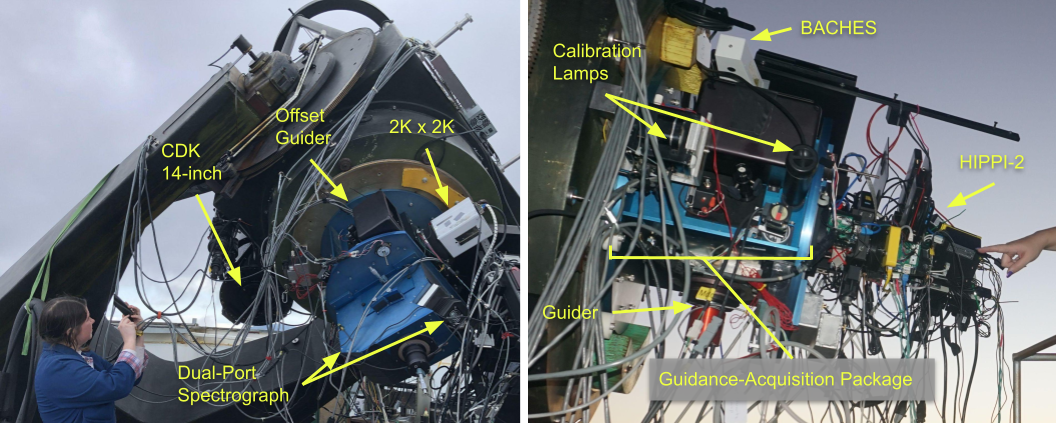The Occultation of a 15.2 Magnitude Star by (5000) Quaoar
May 13, 2023 at 1:44:14am
MIRA Newletter article on our 2 day observing run
This is a high value event with the opportunity to better characterize the newly discovered rings around this, the first Kuiper Belt Object discovered (not counting Pluto, of course). The path for the event is unlikely to shift far enough south to give an occultation by the main body, but a miss would be valuable to improve astrometry. Most important is the rings, which indeed are occulted from MIRA. As of May 1, there are 11 other tracks on OccultWatcher, nearly all are inside the southern limit and far from Monterey Bay sites. I'm seeking, with the help of the MIRA staff, to use their 36" reflector at the Oliver Station on Chews Ridge, to video record the event. The 2 rings should both be occulted within the track for Chews Ridge.
Tune-up at MIRA - The Occultation of a 10.1 (combined magnitude) Target by Eunomia on Friday morning May 12 at 3:53:16 am.
22 degrees altitude in Sagittarius. Only a 0.10 magnitude drop, the duration is 76 seconds permitting short integration to get high accuracy. It should be do-able even in our 8" scopes. The target star is magnitude 12.8, which by itself should be doable with good accuracy at a high dark site at 2x. Probably have to reduce gain quite a bit to avoid saturation. Saturation of pixels will be the killer, a saturated image won't show any dip at all, of course. Also, the target is rather close to a brighter 9.6 magnitude star. This event has a separate page for the charts and results
Quaoar Occultation
The OWcloud prediction page is here.
John Broughton, in Australia, got good QR1 ring occultation data from small telescopes for a Quaoar event in 2021, shown below.

John Broughton's data for the 2021 occultation of a 14.3 magnitude star. Integration times shown in black. "Mv= 14.3; Mr=13.8, altitude ~70 and moonless in a moderately light polluted sea-level location. Under the same circumstances but observing at 26 degrees altitude at a 5,200 ft dark site would produce better results than that. My observation was a drift-through and collimation was a bit out too, so not very sharp images. I now have tracking working and adjusted the collimation for our upcoming events." |
The May 13 event happens in the southeast, rising, at 26 degrees altitude and 137 degrees azimuth. A central occultation by the main body would last 69 seconds. To get the outer Q1 ring and sample beyond this as well, an observing taping period of 11 minutes centered on the central event time is recommended. Begin taping at 1:38:00 am, and end at 1:50:00 am PDT, to also make room for the 31 second 1-sigma time error. Here's the Lucky Star portal link page to the event. I'm hoping to get specialized predictions for MIRA, promised by Lucky Star.
The vitals: V=15.18, R=14.44 for a V-R of 0.74, which is comparable to a spectral type K2 star, somewhat like Arcturus in reddishness. The magnitude drop in R is 3.98 magnitudes. RUWE is 1.05, which is within limits to be acceptable star position accuracy.
The 36" Reflector's long/lat/elevation is at
W. Long = 121 34' 00.30"
N. Lat = 36 18' 21.02"
Elev = 5,000 ft exactly, for the focus level mounting point. From GoogleEarth Pro.
Scaling from John Irwin's post showing a central occultation and ring contacts, and placing our own track 1/3 diameter beneath, I get the outer ring contact is 3min 59s earlier than the central occultation time. And, 1min 45s later than central occultation time for the 2nd occn of the outer ring. So that's 6 min of total interval to cover both, but go 10 min to be sure.

OW cloud data. The default prediction is the GAIA DR3 from JPL #43, which is dated one day after our Aug 8 '22 occultation and presumably incorporates the many chords which successfully recorded that event. |

OW Desktop data, with MIRA Observatory as our claimed site. |

The target star is in an extremely dense star field in Scutum - the Scutum Star Cloud. |

At higher magnification. The star charts here on this row are for an equatorially mounted 2-mirror system so no field flipping is included. The orientation will very likely have to be rotated to match the visual look. The Planewave 14" has this. Primary and secondar mirrors only. |
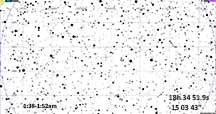
At a scale probably more appropriate for the 36" scope. The LCD square is still sized for using the 0.5x reducer. But, I tentatively think it'll be best to not use the 0.5x focal reducer on the nosepiece, to minimize trouble with excluding other fainter stars. Again assumes 2-mirror system. We'll experiment on Thursday eve and see what will work best. |
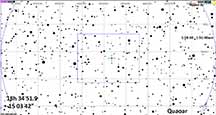
MIRA informs me that the spectrograph port on the 36" which we'll be using, is a 3 mirror system, so that we'll need to flip the chart horizontally. This chart is for a "flipped" horizontal orientation, with the LCD chip view for the 36" shown. |

The Q70 eyepiece will be in the same diagonal so it too is 'flipped' here, and at the estimate scale for the 36" f/10. |
|
|
|
The 36" MIRA scope is an f/10 telescope, so the FOV of the 32mm Q70 eyepiece should be 8"/36" x FOV(8SE scope). The 36" scope will gather 20x the light of our 8SE scopes, so that the magnitude improvement will be 3.27 magnitudes. A 15.2 magnitude star will look like a 12.0 star looks in our 8SE scopes, which is visible by eye in the 8SE eyepiece only with difficulty. However, there are two 10.2 stars near the target which will look as bright as V=7 stars in an 8SE. Quite bright.

The Q70 eyepiece field of view, scaled from the 8SE but for an f/10 36" |

With the 0.5x nosepiece adapter, I calculate the FOV of the chip on the Watec will be this; only 3'24" wide. The two v=10.2 stars are just off the chip, on the right side. |

SDSS photo from the OWcloud site. Very crowded field, with three 17th magnitude stars only 7" away. |

The star field |
|
Orientation of the Rings and Path Direction
Quaoar is so far from the sun, and so slow, that it spends nearly 6 months in retrograde motion. The Aug 9, 2022 occultation was 42 days after opposition, and the May 13, 2023 event is 47 days before opposition; in both cases a little over a month from opposition. I conclude both events happen during retrograde motion. I then took the sky plane of the rings and occultation observer tracks from the Aug 9 '22 event and combined with the May 13 '23 OCCULT4 path shown in the IOTA board posting by Dave Herald, to derive the track for MIRA Observatory and how it intersects the rings. Using 69.2s per diameter, I could then scale approximate times for the ring contacts. Results at left in the table below. However, this differs from the John Irwin and Lucky Star predictions that followed later.

The Quaoar path for May 13, 2023. The time error is up to 31 seconds and there's even a small chance we'll get the main body briefly. |

John Irwin published this in the IOTA message board. I added an approximate offset for MIRA Observatory and scaled the QR1 first and 2nd contact times using 69 seconds = full diameter of Quaoar. It's rather a big difference vs the first construction I made using the OCCULT4 data as I interpretted it. Not sure which is the one to trust, so we'll record long enough to get the rings regardless of which projection is correct.
John Broughton, after his successful ring occultation QR1 last year, with a smaller scope, feels that 8X is a good comprise for us... "We observed a deep 1.3s occultation across a narrow section of the Q1R ring. Most of it is tenuous and broader, so if I were observing I'd set an integration of 8x to increase the SNR without compromising the detection of the narrow part. |

The plot came from Chrystian Periera, author of the '22 Quaoar paper. If this is simply left-right flipped from the John Irwin plot, then the first and second contacts (the 'd' and 'r' labelling) is correct. |
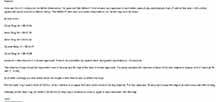
John Irwin sent an email with these predicted times for MIRA Observatory for the rings. |

Lucky Star's Felipe Braga sent these predictions, based on the northern of the two prediction orbits, which made more use of past occultations and he felt was more reliable. This is for ring QR1 contact times for MIRA Observatory |

And for the new ring QR2 times |
|
|
|
Trail Running on Friday Day Time!
I'd like to do a Friday trail run to China Campground 1.4 miles away down towards Tassajara, then up Pine Ridge trail. It would be nice to be near shade and water. We'll be busy both nights at the Observatory, though. Friday looks clear with low of 49F and high of 77F on Friday. I am making a separate webpage for images from my trail running, posted on a separate webpage case MIRA personnel would like to use any for their materials.
Thanks to help from Jean and Dan at MIRA, we had a successful 2 nights of observing. We recorded both the Eunomia event, and the Quaoar event on both the 36" f/10 and on the new Planewave 14" f/7.2. We decided to have Kirk use the 36", as the Watec camera I have lent to him is a little less noisy than mine. We decided to mount the 0.5x reducer on Kirk's Watec at the last minute, as the seeing was poorer than the prior night and the star light more spread out and we feared lack of good signal/noise. The 0.5x reducer boosted by-eye observability on the monitor significantly. I used the 14" Planewave w/o reducer and could see the target star visually on the monitor on virtually every 16x integration. Reductions will follow. We also got a rich selection of photography of the instrumentation, the skies, the activities as we calibrated and made imaging parameter choices, flat fielding, dark frames... and I also got a few targets on the GTF81 with Losmandy mount and my Nikon D7000 camera for student use in the astrophotography class this coming week. Jean and Dan were most helpful, and eager to do more good science in this area in the future.
Richard Nolthenius Data: Pyote Log File
My data was taken on the smaller scope - the 14" f/7.2 Planewave cassegrain. I set the Watec 910hx/rc camera at maximum sensitivity - Gamma=1, Gain=41, Sharpness=max, Integration 16x. The telescope tracked beautifully and frame to frame migration of the aperture was minimal. The 15.18 star was dim, but could be followed on virtually every frame. However, shallow drops in magnitude would not be detectable unless they lasted longer than a second or two, and the maximum expected duration of the denser ring QR1 occultation was only about 2 seconds. A full drop would be well detectable over 2 seconds.
In order to make the file sizes managable on standard thumb drives, I downloaded the raw video into an avi file in two stages, with a ~10 second overlap in time to not lose any data. They're labelled "Quauar1" and "Quaoar2". PyMovie version 3.7.67z was used for this analyzis.

PyMovie composite of light curves. The target is in red |

Screen capture, with the target in its 5px radius circular aperture, showing the aperture properties selected. |

Zoomed in. Contrast adusted to 115 to better show the target above sky. |

The target light curve in PyMovie, using aperture photometry. At 16x setting, there are 8 frames almost identical, for each integration. These 8 frames will show as bunches of very similar readings. They'll be combined into a single integration in PyOTE. |

Light curve of "ref" reference star, in PyMovie. |

The second reference star. The ref stars were brighter than the target, so had less point-to-point scatter. |

Blank sky near the target. |

The PyOTE reduced light curve, using the smoothed reference star (top light curve) to calibrate the Quaoar light curve below. The predicted time of the QR1 ring first contact is marked by the vertical line |
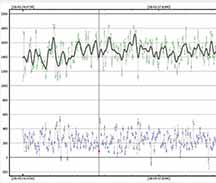
The PyOTE light curve for the QR1 ring predicted 2nd contact (vertical line). |
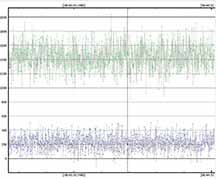
The first contact of ring QR2, at the vertical line. The discovery recordings of this ring from the Aug 9, 2022 occultation only recorded a very low opacity dip from the largest telescopes on Earth; the Gemini North, and CFHT telescopes . Not surprising it didn't show here. For this light curve, I did not use smoothing, which in any case didn't help show ring crossings. |

The second contact of ring QR2, at the vertical line. Again, no hint of an occultation. |
|
|
|
|
The last half of my Planewave 14" recording interval (8:44:24 to 8:50:02 UT) was done on a separate download, and covered the last ring contact; of QR1. There's no hint of partial or complete target light loss during the contact times, also confirmed on Kirk Bender's record on the larger 36" telescope. At least, these provide good limits on the opacity of the ring at these azimuths. They add evidence that ring QR1 does not have evenly spread material. It might clump due to resonances with the more distant moon Weywot. It's interesting that these rings both lie outside the Roche Limit, significantly. This brings questions to their origin, for which we don't have answers to, yet. New science to be done here!
 |
 |

Composite light curve from the 2nd .avi download. |

The target light curve, in PyMovie |

Because of drift during the 13 minute observing period, the upper reference star could not be used, as it had drifted up, and off chip. I chose another. |

The second reference star was the same as used in the early .avi tape. |

Zoomed in on the predicted time of the QR1 second contact. |
Kirk Bender's Data on the 36" Telescope
Kirk recorded at 8x integration, double the time resolution of mine on the 14" scope. The 36" scope projected much more into the strong 15mph variable wind that we noted this night. The 14" Planewave scope was lower, beneath the 36" and more protected by the Observatory walls. The plate scale was much larger for the 36", also amplifying the visibility of the shake as noted by Kirk on the monitor. Here's his commentary on settings and reductions...
gain 41
gamma 1.0
sharpness 18
The version numbers for my IOTA report are in the PyMovie csv file and the PyOTE log files.
They are PyMovie = 3.7.68w and PyOTE = 5.2.4.
I used PyMovie 3.7.49, 3.7.66, 3.7.67 on other runs for Quaoar.
I used AP mode in PyMovie, settings are in the screenshot on your page.
I did not see saturation in the tracking star.
For the report I used dynamic (snap to blob) for the target and tracking stars, because at such high magnification and wind, the star images were jiggling around: image shake due to wind, even though (presumably) no scope shake. At my 8x, the stars were moving twice as fast as your 16x.
I tried static apertures but I still got much the same curves, with the big jiggle towards the end in the tracking and target.
I tried NRE for one run, same waviness.
Apparently the normalization can't smooth (completely) the target against the tracking star for that last dip.
I tried different tracking stars, they all have that waviness.
I don't know either why my curves are wavy.
I did make some long exposure photos that don't appear to show clouds.
We were looking at the same patch of sky, but on the other hand our scopes are quite different, maybe the effects were more close range.
The 36" is less shielded from wind, the secondary protrudes unshielded up into the air, whereas yours is inside the tube and your scope was more shielded overall.
I'm not saying scope shake, because we were both attached to the same mount, but rather air currents.
I don't recall bumping the camera or anything else, I'd think any bumping might transmit to the 14" as well.
And that last dip is at least 10 seconds long, too long for a simple bump.
I recorded from 8:36:01 to 8:50:09, that last dip was about 8:48:19 to 8:48:37.
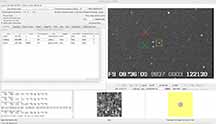
Note that Kirk's imaging is right-left reversed from mine. He had an additional mirror in the optical system: primary, secondary, diagonal. I had only the primary and secondary mirrors in the 14". |

It's interesting that on this recording, there's modulation in the light of both target and reference star that were significant. These were not evident in the 14" scope, and of course looking through the same airmass to within 1 meter of cross-path. In part this might be masked in the 14" data because of lower signal from the smaller light gain. |

These modulations are still visible in the PyOTE reference calibrated recording. I'll say, that there was significant re-programming of PyMovie happening during the weeks during and after this important occultation, and might be relevant. From Kirk's recording here, it was assumed there were thin aerosols responsible for these, but such modulations would then be seen in my data on the 14", and are not. Perhaps wind? Perhaps the tracking of the apertures was not perfect even using the 0.5x reducer? We're pondering... |
Because the occultation predicted event time had a formal 1-sigma uncertainty of 30 seconds, and because the rings intercepted the target star at a shallow angle, the actual times of the ring contacts is rather poorly predictable, and ring dip events might happen as much as a minute before or after the nominal predicted time.
Kirk's excellent video on our trip. Snippets from various times during our 2 day adventure. On YouTube
Summary on Observations of this Event
The LuckyStar group in Europe has analyzed all the data from this and other observers, and concluded that no evidence of the rings was seen. However, the MIRA 36" was the largest telescope within the path area, and nothing comparable to the Hawaii big scopes were in the shadow path to get data, unlike for the August '22 event.







